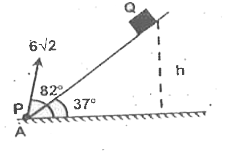A particle A having a charge of 2.0×10−6 C and a mass of 100 g is placed at the bottom of a smoth inclined plane of inclination 30∘ . Where should another particle B, having same charge and mass, be placed on the incline so that it may remain in equilibrium?
To solve the problem, we need to find the position of particle B on the inclined plane such that it remains in equilibrium under the influence of gravitational and electrostatic forces. Let's break down the solution step by step.
Step 1: Understand the Forces Acting on Particle B
- Particle A is at the bottom of the incline with a charge q1=2.0×10−6C and mass m=100g=0.1kg.
- Particle B, which has the same charge and mass, is placed at a distance x up the incline.
- The forces acting on particle B include:
1. The gravitational force (Fg) acting down the incline: Fg=mgsinθ
2. The electrostatic force (Fe) due to particle A: Fe=kq1q2r2, where r=x.
Step 2: Calculate the Gravitational Force
- The angle of inclination θ=30∘.
- The gravitational force component acting down the incline is:
Fg=mgsin(30∘)=mg⋅12=0.1⋅10⋅12=0.5N
Step 3: Set Up the Electrostatic Force Equation
- The electrostatic force between the two charges is given by:
Fe=kq1q2x2
where k=9×109N m2/C2.
Step 4: Equate the Forces for Equilibrium
- For particle B to be in equilibrium, the electrostatic force must balance the gravitational force:
Fe=Fg
kq21x2=mgsin(30∘)
Substituting the known values:
9×109(2.0×10−6)2x2=0.5
Step 5: Solve for x2
- Rearranging the equation gives:
x2=9×109(2.0×10−6)20.5
x2=9×109⋅4.0×10−120.5
x2=9×109⋅8.0×10−12=72×10−3
Step 6: Calculate x
- Taking the square root gives:
x=√72×10−3=√0.072≈0.268m
Final Answer
- Particle B should be placed approximately 0.268m up the incline to remain in equilibrium.
- Particle A is at the bottom of the incline with a charge q1=2.0×10−6C and mass m=100g=0.1kg.
- Particle B, which has the same charge and mass, is placed at a distance x up the incline.
- The forces acting on particle B include:
1. The gravitational force (Fg) acting down the incline: Fg=mgsinθ
2. The electrostatic force (Fe) due to particle A: Fe=kq1q2r2, where r=x.
- The angle of inclination θ=30∘.
- The gravitational force component acting down the incline is:
Fg=mgsin(30∘)=mg⋅12=0.1⋅10⋅12=0.5N
- The electrostatic force between the two charges is given by:
Fe=kq1q2x2
where k=9×109N m2/C2.
- For particle B to be in equilibrium, the electrostatic force must balance the gravitational force:
Fe=Fg
kq21x2=mgsin(30∘)
Substituting the known values:
9×109(2.0×10−6)2x2=0.5
- Rearranging the equation gives:
x2=9×109(2.0×10−6)20.5
x2=9×109⋅4.0×10−120.5
x2=9×109⋅8.0×10−12=72×10−3
- Taking the square root gives:
x=√72×10−3=√0.072≈0.268m
- Particle B should be placed approximately 0.268m up the incline to remain in equilibrium.
Topper's Solved these Questions
- ELECTRIC FIELD AND POTENTIALBOOK - HC VERMACHAPTER - ELECTRIC FIELD AND POTENTIALEXERCISE - Objective 2
8 Videos
- ELECTRIC CURRENT THROUGH GASESBOOK - HC VERMACHAPTER - ELECTRIC CURRENT THROUGH GASESEXERCISE - Exercises
23 Videos
- ELECTROMAGNETIC INDUCTIONBOOK - HC VERMACHAPTER - ELECTROMAGNETIC INDUCTIONEXERCISE - EXERCISE
9 Videos
Similar Questions
(a) Two charged particles , each charge q, are joined by an insultating string of length L and system is kept on smooth surface. Find tension in the string.
(b) A particle having charge Q0 is placed directly below and at separation d from the bob of simple pendulum at rest. The mass of the bob is m. What charge should be given to bob so that string becomes loose ?
( c) A particle A having charge q and mass m is placed at the bottom of a smooth inclined plane of inclination θ. Where should a block B , having same charge and mass , be placed on the incline so that it may remain in equilibrium ?
View SolutionA particle of mass 0.2 kg has an intial speed of 5ms−1 at the bottom of a rough inclined plane of inclination 30∘ and vertical height 0.5 m . What is the speed of the particle as it reaches the top of the inclined plan ? (Take μ=1/√3,g=10ms−2 ) .
View Solution
Knowledge Check
A particle A having charge of 2.0×10−6C and a mass of 100 g is fixed at the bottomk of a smooth inclined plane of inclination 30∘. Where should another particle B having same charge and mass, be placed o the inclined plane so that B may remain in equilibrium?
A8 cm from the bottomB13 cm from the bottomkC21 cm from the bottomD27 cm from the bottomA particle having the same charge and 200 times greater mass than that of electron is
APositronBProtonCNeutrinoDMesonA block of mass 10kg is pushed up on a smooth incline plane of inclination 30∘, so that it has acceleration 2m/s2. The applied force is
A50 NB60 NC70 ND80 N
A particle having a charge of 2.0×10−4C is placed directly below and at a separtion of 10 cm from the bob of a simple pendulum at rest. The mass of the bob is 100g. What charge should the bob be given so that the string becomes loose?
View SolutionA particle (P) is projected at an angle of 82∘ from horizontal with a velocity 6√2m/s from the bottom of an inclined plane, having angle of inclination 37∘ At the same instant, another particle: Q is released from a heighth on a smooth incline plane. If after some time both particles collide, then find the
(a) value of time after which they collide,
(b) the height h

View SolutionTwo particles A and B having charges 8.0×10−6C and −2.0×10−6C respectively are held fixed with a. separation of 20cm. Where should a third charged. particle be placed so that it dose not experience a net electric force?.
View SolutionA particle is fired horizontally form an inclined plane of inclination 30∘ with horizontal with speed 50ms−1. If g=10ms−2 , the range measured along the incline is
View SolutionA body of mass 5kg is moved up over 10m along the line of greatest slope of a smooth inclined plane of inclination 30∘ with the horizontal. If g=10m/s2, the work done will be
View Solution
